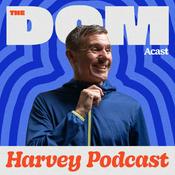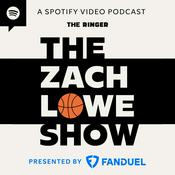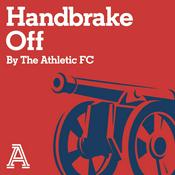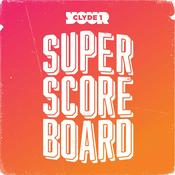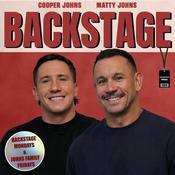271 episodes

Sean Miller on Handling the "Gray Areas" of Pressure, Tough Transition Actions, and Guards Hedging Ballscreens {Texas}
19/12/2025 | 1h 5 mins.
Slappin' Glass sits down this week with the Head Coach of Texas MBB, Sean Miller! In this highly insightful conversation from when Coach Miller was at Xavier, the trio dive into Coach Miller's thoughts on all things about handling pressure, including playing through the "gray areas" of it, and discuss transition defensive concepts and teaching guards to hedge ballscreens during the always fun "Start, Sub, or Sit?!"To join coaches and championship winning staffs from the NBA to High School from over 60 different countries taking advantage of an SG Plus membership, visit HERE!

Evan Miyakawa on Preventing the "Kill Shot", Useful vs. Interesting Analytics, and Deciphering Lineup Data
05/12/2025 | 1h 11 mins.
This week on Slappin’ Glass, we’re joined by data scientist and creator of the rapidly growing college basketball analytics platform EvanMiya.com, Evan Miyakawa. Evan’s work has become a trusted resource for coaches at every level—particularly those looking to cut through the noise of early-season statistics and understand which metrics actually matter.In this conversation, Evan shares how coaches can separate interesting numbers from useful ones, why certain teams have unique statistical fingerprints that predict success, and how lineup data can be leveraged far more effectively than most programs currently use it. We also unpack defensive priority stats (threes, rim, free throws), halftime box score interpretation, and the origins of Evan’s “kill shot” metric—his way of measuring and predicting momentum swings across a season.Whether you’re analytics-comfortable or analytically curious, Evan offers a clear, practical roadmap for applying data without drowning in it. What You’ll Learn1. How to Separate Useful Analytics from Interesting NoiseEvan explains why the highest-value decisions come from combining your coaching intuition with clean, adjusted data—not relying fully on either side. He details how to weigh early-season sample sizes, refine priors, and avoid overreacting to statistical outliers. 2. Identifying the 2–3 Metrics That Predict Your Team’s SuccessTeams often win and lose in repeatable ways. Evan breaks down how programs can identify their own “keys to victory,” giving coaches clarity on what to prioritize in practice, scouting, and game planning. 3. Making Better Lineup Decisions (and Avoiding the Small-Sample Trap)Learn why 30 possessions can reveal a spark worth exploring, why 100+ possessions create real confidence, and how lineup data—properly adjusted for opponent strength—helps avoid misleading results. 4. How to Read a Halftime Box Score with Meaningful PurposeEvan shows which stat pairings matter most and how to judge whether a discrepancy is signaling a real problem or simply reflecting tempo and game context. 5. Prioritizing Defensive Outcomes: Threes, Rim, Free ThrowsA clear breakdown of how these three areas interact, and why understanding your opponent’s tendencies can simplify what your defense should take away. 6. The “Kill Shot”: Understanding and Predicting Momentum RunsEvan’s 10–0 run metric reveals why preventing opponent runs is more predictive of elite performance than generating them—and why the duration of a run often tells the real story.7. Coaching the Moments Around RunsFrom smart timeout usage to identifying schematic breakdowns, you’ll learn how to stop a slide early or create momentum without burning resources unnecessarily.To join coaches and championship winning staffs from the NBA to High School from over 60 different countries taking advantage of an SG Plus membership, visit HERE!

Dwaine Osborne on Elite Shot Selection, ATO Construction, and Grading the "Tagging Up" System {Youngstown State}
21/11/2025 | 1h 19 mins.
Episode SummaryIn this episode, Slappin’ Glass sits down with Youngstown State Associate Head Coach Dwaine Osborne, one of the most consistently efficient offensive coaches in college basketball. Osborne — an eight-time Coach of the Year with a track record of leading the nation in effective field-goal percentage and offensive efficiency — opens the doors to his philosophy on building highly disciplined, analytically driven teams.Across a wide-ranging conversation, Coach Osborne unpacks how he teaches elite shot selection, builds paint efficiency, and uses clarity-based concepts to help players make decisive first-touch decisions. He details why “life is math,” how he leverages PPP values to communicate shot quality, and why playing off two feet may be the most under-taught skill in modern offense.The episode digs deeply into layup packages, Villanova footwork, decision-making progressions, and the balance between analytics and empowering confident, aggressive scorers. Coach Osborne also breaks down how he thinks about ATOs, why fewer plays lead to better execution, and how his program blends tagging-up rules, offensive rebounding, and transition defense into one integrated system.Throughout, he brings humility, candor, and clear teaching language — making this an episode loaded with transferable concepts for coaches at every level.What You’ll LearnHow to Teach and Enforce Shot Selection Practical ways Osborne uses analytics (PPP numbers, film pauses, peer accountability) to build a team-wide understanding of shot value.Why Efficient Offense Starts With Player Strengths How defining each player’s “best value actions” leads to higher-percentage possessions and clearer roles.Developing First-Touch Decisions (FTDs) Methods to help players make decisive reads on the catch — not predetermined, but anticipated through clarity and structure.Building Paint Efficiency Why all layups are not created equal, how Osborne categorizes finishing packages, and how playing off two feet mirrors traditional post play.Using Concepts, Not Just Plays How his teams layer the same concepts (Denver, Flash, Laker, Wyoming, etc.) out of multiple alignments to stay unpredictable and comfortable in late-game moments.ATO Construction and Why Less Is More The philosophy behind keeping the ATO menu small, emphasizing execution, and choosing between attacking defensive tendencies or preventing them.The Tagging-Up System: Four Simple Rules A clear explanation of the “touch, top, no reckless crash, no advance” framework — and how it improves both offensive rebounding and transition defense.How to Balance Analytics With Player Confidence His approach to ensuring players feel empowered, not restricted, while still understanding efficiency and role clarity.Culture, Trust, and Prioritizing People Why recruiting for character and building meaningful relationships is foundational to executing an analytical system.This episode is a masterclass in clarity-driven coaching, teaching with precision, and building efficient offense without sacrificing player confidence or freedom.To join coaches and championship winning staffs from the NBA to High School from over 60 different countries taking advantage of an SG Plus membership, visit HERE!

Justin Bokmeyer on Structures for High Performance Environments, the Value of Pre-Mortems, and Systems Thinking {Brooklyn Nets}
07/11/2025 | 48 mins.
This week on Slappin’ Glass, we sit down with Justin Bokmeyer, Director of Basketball Operations for the Brooklyn Nets, to explore how great teams build sustainable, high-performance environments.With a background spanning West Point, MLS Next, and the NBA Academy, Justin shares powerful lessons on leadership, systems thinking, and developing people-first organizations that thrive under pressure.🧠 What You’ll LearnPeople Over Hardware: Why elite performance starts with hiring, aligning, and empowering the right people.Systems Thinking: How to connect decisions across departments to reduce silos and improve trust.Onboarding and Role Clarity: The overlooked key to alignment and long-term success.Decision-Making Frameworks: How Justin uses pre-mortems, decision journaling, and pushing decisions to the lowest level to build accountability and clarity.Military Leadership Lessons: Applying principles like shared mission, healthy ego, and accountability from West Point to professional sports.🔁 Key Quote“High performance is a people-first business. Get the right people in the right roles, and everything else follows.”Tune in to learn how the Brooklyn Nets’ Justin Bokmeyer blends leadership, decision science, and culture-building to create environments where teams can grow, compete, and sustain excellence.To join coaches and championship winning staffs from the NBA to High School from over 60 different countries taking advantage of an SG Plus membership, visit HERE!

Ken Pomeroy and Jordan Sperber on Analytical Tradeoffs, Fouling Up 3?, and the Nuances of Shot Selection Metrics
31/10/2025 | 1h 3 mins.
In this episode, Slappin’ Glass is joined by Ken Pomeroy and Jordan Sperber, creators of the course Basketball Analytics for Coaches. They dive into how data can sharpen decision-making, refine strategy, and help coaches think more clearly about how they play and teach the game.🧠 What You’ll Learn:1. Rethinking Pace Why pace isn’t just about speed — it’s about possession quality and efficiency. Learn how teams like UConn and Alabama succeed with drastically different tempos, and why coaches should focus on avoiding late-clock possessions instead of simply playing faster.2. Offense, Defense, and What Really Wins Is “defense wins championships” still true? Ken and Jordan explain why elite offense has become slightly more predictive of winning in today’s spacing-heavy game and the connection between pace and defensive quality.3. The Real Story Behind Shot Selection Discover why the best teams don’t always take the “best” shots — and how marginal gains, like trading a few long twos for threes or cutting out floaters, can create meaningful offensive improvement without overhauling your roster.4. Using Analytics in Late-Game Decisions From quick two vs. three, to foul or defend up three, to playing stars in foul trouble — learn how data can help coaches define their philosophy ahead of emotional, high-pressure moments.5. What Stats Actually Matter Ken and Jordan reveal which numbers predict success: two-point percentage and shot selection stability — not three-point streaks or halftime box scores. Coaches will learn what to track, what to ignore, and how to use numbers to reinforce team values.🏀 Key Takeaway:Analytics isn’t about replacing instincts — it’s about creating a framework to think better. Whether it’s pace, shot selection, or in-game strategy, data helps you coach with clarity and confidence.To join coaches and championship winning staffs from the NBA to High School from over 60 different countries taking advantage of an SG Plus membership, visit HERE!
More Sports podcasts
Trending Sports podcasts
About Slappin' Glass Podcast
Listen to Slappin' Glass Podcast, The Dom Harvey Podcast and many other podcasts from around the world with the radio.net app

Get the free radio.net app
- Stations and podcasts to bookmark
- Stream via Wi-Fi or Bluetooth
- Supports Carplay & Android Auto
- Many other app features
Get the free radio.net app
- Stations and podcasts to bookmark
- Stream via Wi-Fi or Bluetooth
- Supports Carplay & Android Auto
- Many other app features


Slappin' Glass Podcast
download the app,
start listening.
